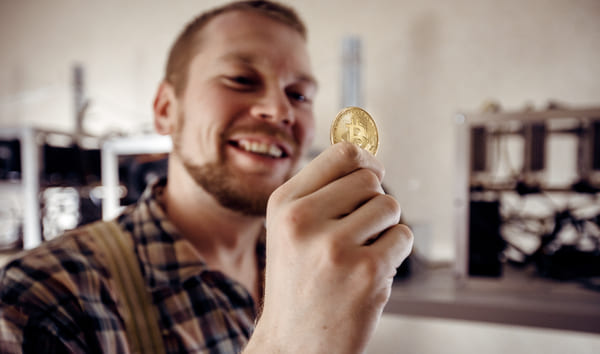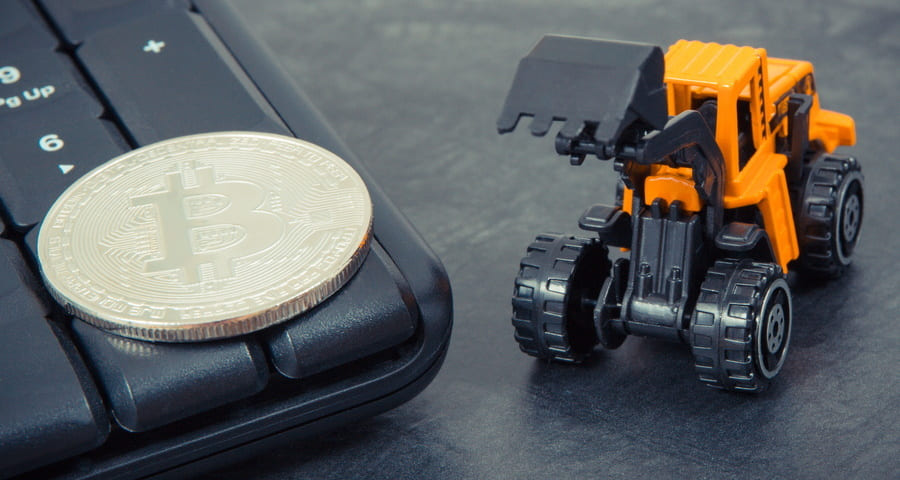Cryptocurrency mining is one of the most puzzling activities associated with cryptocurrency systems such as Bitcoin and Ethereum. It requires advanced computer hardware with which “miners” extract more bitcoins. We discuss all the details of this process below.
- The number of people interested in cryptocurrencies is rising
- What is a bitcoin miner?
- What is the difference between a bitcoin miner and a computer?
- The Proof-of-Work algorithm, how to mine efficiently?
- How does PoW work?
- Types of Cryptocurrency miners
- What is bitcoin mining and is it worth investing in?
- How does a Cryptocurrency miner work?
- SUMMARY
The number of people interested in cryptocurrencies is rising
Virtual money is gaining an increasing number of supporters, especially among younger generations who are accustomed to electronic banking and many other technological conveniences. Many individuals already hardly use cash at all, making payments by debit card or online transfers. Perhaps this Social trend will accelerate, and we will observe radical changes in the current monetary system.
Debates take place all over the world regarding the possible replacement of traditional money with virtual equivalents. No wonder that the number of people interested in cryptocurrencies is on the rise, particularly the most recognizable ones (Bitcoin, Ethereum). While knowledge of the mechanisms governing these systems is not necessary to use cryptocurrencies, curious readers will probably want to understand how it works.
What is a bitcoin miner? In this article, we will try to introduce you to the complicated process of Cryptocurrency mining, initiated by “miners”, i.e. people with high-tech computer equipment, with the help of which you can mine more bitcoins from the system’s resources. We also encourage you to read other articles from our website in which the topic of Cryptocurrency mining was mentioned several times.
What is a bitcoin miner?
A bitcoin miner is a machine with very high computing power. It could be compared to a PC. But while the computing power of a home computer is used to generate virtual worlds in computer games for instance, a Cryptocurrency miner uses all its power to solve complex mathematical tasks, the solution of which is an essential condition for the confirmation of transactions made by users of the system. With the help of excavators, “miners” emit New bitcoins during this process.
Cryptocurrency mining is based on so-called distributed computing, which uses the computing power of several devices (importantly, these devices can be geographically dispersed). Just as it is possible to check the performance of a personal computer that we use for work and entertainment, the performance of an miner can also be measured – in hashes per second. The equipment of a Cryptocurrency miner consists of a set of graphics cards or specialized chips to perform calculations based on specific algorithms. The latter are expertly called ASICs. One of the most efficient excavators of this type is the Antminer S17 – equipment that performs calculations using the SHA-256 algorithm.
What is the difference between a bitcoin miner and a computer?
A bitcoin miner resembles the computers we use every day in several ways. It also uses computing power, consists of similar components, and comes with its own software. On the other hand, it differs from a regular computer in a fundamental way. First of all, the scope of work performed is extended. Home computers do not have enough computing power to be able to perform them all. The excavator is more advanced in this respect: it allows you to perform a huge number of calculations simultaneously. Besides, the components in the miner are chosen to maximize the Hash rate obtained, as well as to achieve an optimal level of power consumption. To achieve even better results, a bitcoin miner can be connected to multiple other miners – then the total computing power increases and the chances of emitting another bitcoin increases as well. Such a set of interconnected miners with very high computing power is called an miner pool or a cryptocurrency mine.
To sum it up: ordinary computers are no competition for cryptocurrency excavators, which are specialized devices used only to emit additional bitcoins. Their functioning is similar, but they represent two separate categories of devices.
The Proof-of-Work algorithm, how to mine efficiently?
One of the most important algorithms in the bitcoin system is the Proof-of-Work (PoW) algorithm. We mention it here as it is also utilized by the bitcoin miner. PoW was originally used to provide anonymity to internet users, but over time it has found other purposes as well. The idea behind this algorithm comes down to a very simple principle: all calculations are to be performed by the processor.
In order to connect to the Cryptocurrency network, each user must perform a certain mathematical task. However, this task requires such complex calculations that probably no one would be able to cope with it using just a calculator. Therefore, in order to connect to Bitcoin, one must have a Cryptocurrency miner that uses its computing power to validate payments made on the network. Such an miner can be an ordinary PC, though of course the average Bitcoin user has virtually zero chance of mining effectively.
Proof-of-Work is based on the so-called proof of work done by the device (hence the name). PoW is similar in structure to an algorithm called Sudoku – the mathematical task is difficult to perform, but easy to check by the rest of the network. Incorrect calculations are Instantly detected by the system, and Bitcoin ignores them.
How does PoW work?
The PoW algorithm solves the basic problem of anonymous networks, which is the so-called Sybil attacks. This defines a situation where a hacker bypasses a victim node and tries to access all nodes nearby to take over the information input and output channels. Once these are taken over, it can transmit false data to the victim.
The PoW algorithm, upon which Bitcoin and many other cryptocurrency systems operate, minimizes the risk of a Sybil attack. In the Bitcoin network, a potential victim node selects other nodes at random, which precludes the possibility of one node completely circling the other. Besides, the proof of work performed by a device is not transferred to other blocks (blockchain), so it cannot be stolen. Moreover, the proof cannot be obtained in advance because each new block is an integral part of the structure and contains the checksum from the previous block. Each new proof is only calculated when the next block appears. This allows the PoW algorithm to fairly distribute the reward for mining a block, taking the computational power of the Cryptocurrency miner as the distribution criteria.
To obtain proof of work, the Cryptocurrency miner consumes electricity, which is a real resource that can be easily measured. This makes it easy for PoW to see how much of the reward should accrue to a particular excavator (or mine). Any attempt to mislead the network will be quickly detected, as it would require the investment of huge amounts of computing power, and therefore consume very large amounts of electricity. Cyber-attacks are costly and most often unsuccessful, and it is pointless to search for vulnerabilities in the system. With all these facilities, PoW provides a High level of security to the BTC system.
Types of Cryptocurrency miners
Cryptocurrency miners can be divided into three categories: ASIC, GPU, and FPGA. The type of hardware used to mine BTC, as well as the way it processes information, determines whether a given miner belongs to one of these categories. A characteristic feature of all such devices is their high price. The cost of mining BTC is also not insignificant. Below, we will outline the special characteristics of each of these categories.
ASIC miners
ASIC excavators are the most economical solution because they consume the least amount of power. Their performance, measured in H/W, is higher than that of GPUs. This hardware features very high Hash rates for certain currencies, such as Litecoin. An additional advantage, especially valuable for “miners” who create Cryptocurrency mines, is the small size of ASICs. The Antminer S17, already mentioned above, belongs to this group.
That’s it as far as the advantages are concerned. However, equipment of this type is not without drawbacks. It is characterized by high ingression, i.e. it is suitable for mining only some currencies. With an miner designed for mining Litecoin, you can only mine Litecoins. Want to mine another cryptocurrency? You need to purchase new equipment. There is no denying that this is a serious downside: the cryptocurrency market is constantly evolving; new cryptocurrencies are constantly being developed that you can do great business on. If you have this miner, you are bound to mine a single cryptocurrency only.
Besides, you should remember not to change the hash algorithm, because if you make such a modification, the miner could stop working.
See and follow example offers.
GPU miners
The GPU is the main computing unit in graphics cards: its main task is to perform the calculations necessary to produce Three-dimensional graphics. If it were not for the GPU, the computer’s processor would have to do twice as much work. One of the biggest advantages of a GPU miner that you should pay attention to is its versatility. You can mine any cryptocurrency using it: Bitcoin, Litecoin, Ethereum, Stellar, IOTA and so on.
Using a GPU miner, you are not bound to mining a single currency, as in the case of ASICs. On the other hand, if you want to maximize the results, it is better to choose hardware specialized in mining a particular cryptocurrency. An ASIC miner is much more efficient, and it processes information faster. Additionally, access to all cryptocurrencies does not guarantee financial success.
See and follow example offers.
FPGA miners
FPGA excavators may be called programmable logic gates. They consume very little power (compared to miners which use graphics cards), which results in more profit from mining. FPGAs also generate less heat, run quieter and don’t require as much cooling as GPUs. They fail less often, so you don’t have to service them as frequently, and they are fabulously easy to use. They work practically by themselves (with just the press of a button). They are certainly worth their price.
See and follow example offers.

Thus as you can see, the selection is quite broad.
Therefore, the decision to buy specific equipment should be based on its intended use. You should not be prompted only by the content of advertisements. Want to make money on many different cryptocurrencies? Look for GPU miners. Or perhaps you intend to mine a single cryptocurrency? ASIC and FPGA miners will provide you with optimal results. The high price of these devices may scare you off, but any major investment is a risk. Don’t look for the cheapest offers – if you want to make money from mining, get a Professional excavator. To use it, you do not need to create an account anywhere, as you would on a cryptocurrency stock exchange, for example. You will easily find information about specific models on the Internet, and it is best to start with looking up the devices described on our website.
What is bitcoin mining and is it worth investing in?
Bitcoin mining is a lucrative activity, although it requires advanced computer hardware. We have already described the different types of miners above, now we will move on to describe the Cryptocurrency mining process itself.
You can buy any cryptocurrency in a traditional or cryptocurrency exchange. However, this way of sourcing bitcoins has a disadvantage. The prices of cryptocurrencies, especially bitcoin, change quickly – it is impossible to predict what the rate of the cryptocurrency will be next week, or even the next day. buying bitcoin at an attractive rate can therefore be difficult. Besides, when you create an account on an exchange you have to provide your personal data and email address, which may not be to everyone’s liking.
An interesting alternative to this way of buying bitcoins is to mine cryptocurrencies using special devices. It involves confirming transactions in a distributed database. Of course, a computer does it all – all you have to do is press the right button. Each Cryptocurrency network is based on the uninterrupted operation of so-called node computers, to which new content arrives every second (e-mail works in a similar way). From time to time, miners separate transactions into a separate group (block) and write new data to the register. They receive New bitcoins for performing this operation.
It may appear simple, but in fact there are Complex mathematical calculations involved here that even the greatest genius could not solve. Advanced equipment is required to mine cryptocurrencies. Although the categories listed above are different, the operation itself is similar.
How does a Cryptocurrency miner work?
The cryptocurrency excavator, as we have already mentioned, uses its resources to perform Complex mathematical calculations. In order to mine a block, the computer has to guess an Encrypted string, which is the only trace of the transactions that have occurred. If it succeeds, this string is saved and incorporated into the previous, already approved blockchain).
Every miner works this way, whether it is a computer, smartphone, or special device. The cost of mining digital currencies varies, of course, depending on the hardware used (systems that consist of graphics cards, for example, consume more power).
SUMMARY
Mining BTC requires special equipment, without which it would be impossible to approve further payments and attach them to already existing blocks. Apart from individuals, this is also done by professional companies equipped with powerful Cryptocurrency mines. It is thanks to them that systems such as Bitcoin or Ethereum continue to function. However, anyone can become a “miner”. – you just need to buy the right equipment. The price of some Cryptocurrency miners is dizzying, but the money invested will quickly pay for itself (as long as the cost of mining is not too high). Therefore, it is worth taking up mining with seriousness. Mining is safer than using an exchange-based account, because once you receive BTC for each block mined, you don’t have to worry about anyone gaining access to your funds except you. Things can be different with the stock market. Hackers can, for example, steal your email address and password and then drain your account.

